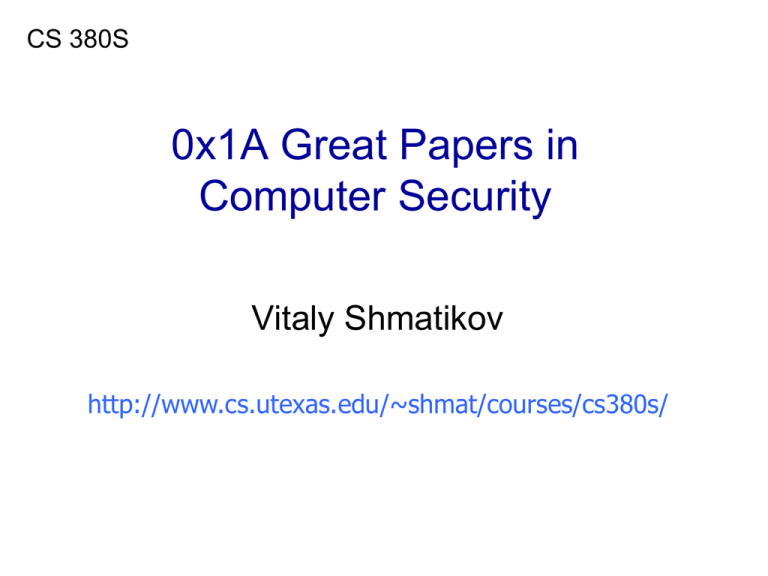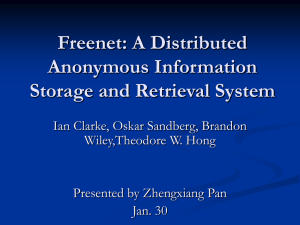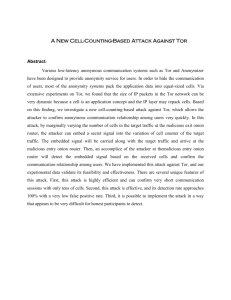0x1A Great Papers in Computer Security Vitaly Shmatikov CS 380S
advertisement

CS 380S
0x1A Great Papers in
Computer Security
Vitaly Shmatikov
http://www.cs.utexas.edu/~shmat/courses/cs380s/
Privacy on Public Networks
Internet is designed as a public network
• Wi-Fi access points, network routers see all traffic
that passes through them
Routing information is public
• IP packet headers identify source and destination
• Even a passive observer can easily figure out
who is talking to whom
Encryption does not hide identities
• Encryption hides payload, but not routing information
• Even IP-level encryption (tunnel-mode IPsec/ESP)
reveals IP addresses of IPsec gateways
slide 2
Anonymity
Anonymity = the person is not identifiable within
a set of subjects
• You cannot be anonymous by yourself!
– Big difference between anonymity and confidentiality
• Hide your activities among others’ similar activities
Unlinkability of action and identity
• For example, sender and his email are no more related
after adversary’s observations than they were before
Unobservability (hard to achieve)
• Adversary can’t even tell whether someone is using a
particular system and/or protocol
slide 3
Attacks on Anonymity
Passive traffic analysis
• Infer from network traffic who is talking to whom
Active traffic analysis
• Inject packets or put a timing signature on packet flow
Compromise of network nodes
• Attacker may compromise some routers
• It is not obvious which nodes have been compromised
– Attacker may be passively logging traffic
• Better not to trust any individual router
– Can assume that some fraction of routers is good, but don’t
know which
slide 4
Chaum’s Mix
Early proposal for anonymous email
• David Chaum. “Untraceable electronic mail, return
addresses, and digital pseudonyms”. Communications
of the ACM, February 1981.
Before spam, people thought
anonymous email was a good idea
Public key crypto + trusted re-mailer (Mix)
• Untrusted communication medium
• Public keys used as persistent pseudonyms
Many modern anonymity systems use Mix as
the basic building block
slide 5
Basic Mix Design
{r1,{r0,M}pk(B),B}pk(mix)
A
B
{r0,M}pk(B),B
{r5,M’’}pk(B),B
C
E
{r2,{r3,M’}pk(E),E}pk(mix)
{r3,M’}pk(E),E
D
{r4,{r5,M’’}pk(B),B}pk(mix)
Mix
Adversary knows all senders and
all receivers, but cannot link a sent
message with a received message
slide 6
Anonymous Return Addresses
M includes {K1,A}pk(mix),
K2 where
K2 is a fresh public key
{r1,{r0,M}pk(B),B}pk(mix)
{r0,M}pk(B),B
B
MIX
A
A,{{r2,M’}K2}K1
{K1,A}pk(mix), {r2,M’}K2
Response MIX
Secrecy without authentication
(good for an online confession service )
slide 7
Mix Cascade
Messages are sent through a sequence of mixes
• Can also form an arbitrary network of mixes (mixnet)
Some of the mixes may be controlled by attacker,
but even a single good mix guarantees anonymity
Pad and buffer traffic to foil correlation attacks
slide 8
Randomized Routing
Hide message source by routing it randomly
• Popular technique: Crowds, Freenet, Onion routing
Routers don’t know for sure if the apparent source
of a message is the true sender or another router
slide 9
Onion Routing
[Reed, Syverson, Goldschlag 1997]
R
R
R1
Alice
R
R2
R3
R4
R
R
R
Bob
Sender chooses a sequence of routers
• Some may be honest, some controlled by attacker
• Sender controls the length of the path
slide 10
Route Establishment
R2
Alice
R1
{R2,k1}pk(R1),{
{R3,k2}pk(R2),{
R3
{R4,k3}pk(R3),{
R4
{B,k4}pk(R4),{
{M}pk(B)
Bob
} k4
} k3
} k2
} k1
• Routing info for each link encrypted with router’s public key
• Each router learns only the identity of the next router
slide 11
Disadvantages of Basic Mixnets
Public-key encryption and decryption at each mix
are computationally expensive
Basic mixnets have high latency
• Ok for email, not Ok for anonymous Web browsing
Challenge: low-latency anonymity network
• Use public-key cryptography to establish a “circuit” with
pairwise symmetric keys between hops on the circuit
• Then use symmetric decryption and re-encryption to
move data messages along the established circuits
• Each node behaves like a mix; anonymity is preserved
even if some nodes are compromised
slide 12
R. Dingledine, N. Mathewson, P. Syverson
Tor:
The Second-Generation Onion Router
(USENIX Security 2004)
Tor
Deployed onion routing network
• http://torproject.org
• Specifically designed for low-latency anonymous
Internet communications
Running since October 2003
• Thousands of relay nodes, 100K-500K? of users
Easy-to-use client proxy,
integrated Web browser
slide 14
Tor Circuit Setup (1)
Client proxy establish a symmetric session key
and circuit with relay node #1
slide 15
Tor Circuit Setup (2)
Client proxy extends the circuit by establishing a
symmetric session key with relay node #2
• Tunnel through relay node #1 - don’t need
!
slide 16
Tor Circuit Setup (3)
Client proxy extends the circuit by establishing a
symmetric session key with relay node #3
• Tunnel through relay nodes #1 and #2
slide 17
Using a Tor Circuit
Client applications connect and communicate over
the established Tor circuit
• Datagrams decrypted and re-encrypted at each link
slide 18
Using Tor
Many applications can share one circuit
• Multiple TCP streams over one anonymous connection
Tor router doesn’t need root privileges
• Encourages people to set up their own routers
• More participants = better anonymity for everyone
Directory servers
• Maintain lists of active relay nodes, their locations,
current public keys, etc.
• Control how new nodes join the network
– “Sybil attack”: attacker creates a large number of relays
• Directory servers’ keys ship with Tor code
slide 19
Hidden Services
Goal: deploy a server on the Internet that
anyone can connect to without knowing
where it is or who runs it
Accessible from anywhere
Resistant to censorship, denial of service,
physical attack
• Network address of the server is hidden, thus
can’t find the physical server
slide 20
Creating a Location Hidden Server
Server creates onion routes
to “introduction points”
Client obtains service
descriptor and intro point
address from directory
Server gives intro points’
descriptors and addresses
to service lookup directory
slide 21
Using a Location Hidden Server
Client creates a route
to a “rendezvous point”
Rendezvous point
mates the circuits
from client & server
If server chooses to talk to client,
connect to rendezvous point
Client sends the address of the
rendezvous point and any
authorization, if needed, to the
server through an intro point
slide 22




